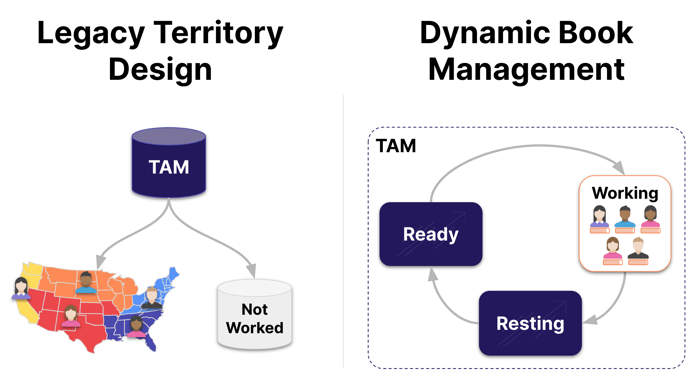Today, we're incredibly excited to introduce you to dynamic book management and our brand new dynamic books solution, Gradient Works Bookbuilder.
Built on best practices from top B2B inside sales teams, dynamic book management is a modern way of allocating accounts to sales reps. Dynamic books increase attainment and improve TAM coverage by keeping reps focused on the best accounts in their market. It’s a true alternative to traditional static territories like geography or named accounts. Dynamic book management continually ensures quota capacity is deployed against the best available accounts.
Enter Gradient Works Bookbuilder, the world’s first dynamic book management software, officially available now. Bookbuilder automates the dynamic books process, ensuring reps always have balanced books with the highest-potential accounts.
You don’t need to do the old way better. You need a new way.
Early Bookbuilder customers have seen incredible results, transforming their sales productivity. Customers are working more accounts, getting more reps on target, and creating more pipeline.
For example, read this case study about how Omnipresent improved SDR performance with a new dynamic books approach, powered by Gradient Works. They’ve seen a 16% increase in opportunity creation, a 66% increase in account touches, and a 63% increase in completed cadences. Reps are happier and more engaged. And every new rep that has started since rolling out the new process is on target. Reps are ramping faster and getting to productivity sooner.
Want to see how a dynamic books approach could work for you? Learn more here.
What is dynamic book management?
Dynamic book management is a flexible and equitable way of allocating accounts to sales reps.
A dynamic books approach relies on books instead of territories. Every rep is assigned a book of accounts - based on an account’s fit and timing and the rep’s available capacity. When a rep converts or disqualifies an account, it moves out of the rep’s book and a fresh new account moves in. Rep books are continually refreshed with new high-potential accounts, while cold or inactive accounts rest.
Why? Because not all prospects in your TAM are created equal. Some aren’t a good fit. Others don’t have the right timing. You need to focus on the highest potential accounts that have both the right ICP fit and are in-market for your solution. So how can you be sure reps are working the right accounts when they’re ready to buy?
Dynamic book management ensures that all of your highest potential accounts are being worked, always. No more static or pre-defined territories. No more overlooked accounts. No more account hoarding.
A traditional territory design model forces you to get it right the first time. A dynamic model allows you to respond to changes in your team or market immediately, and adjust as you need to.

With dynamic books, you can cover all the prospects in your TAM, keep rep books balanced, and continually improve your CRM data.
You can read more about dynamic book management here. We’ve created guides on what a dynamic books approach looks like, as well as how you can implement it in your sales org, and so much more.
What’s wrong with a traditional territory approach?
Only 53% of sales reps regularly hit quota.
Despite all your investments in coaching, training and tools, attainment still suffers. Territory planning takes way too much time, and never produces the results you want.
You’re missing out on revenue because you’re not deploying your reps effectively.
It’s not your fault - it’s because your territory design still relies on methods developed over 100 years ago. 76% of companies still use a geographic territory model to assign accounts to sales reps. And 83% of companies design their territories with spreadsheets.
But opportunity is not distributed geographically.
With a traditional territory model, some reps get territories with so many high-potential accounts they can’t talk to them all, while other reps starve in territories with low potential. The result? Uneven attainment, unhappy reps, unrealized revenue.
“When sales territories are out of balance, organizations spend too much money and time on low-potential customers, while spending too little on high-potential customers. As a result, sales organizations can leave millions of dollars in lost productivity unrealized.” -Forrester Sales Territory Design: A Systematic Approach
100 years ago, this was the best sales teams could do. But we can do better now. That’s where dynamic book management comes in.
We’d love to talk to you about how a more dynamic approach could transform your sales productivity and increase attainment. Want to see how it could work for you? Watch a short demo video or request a personalized demo.





